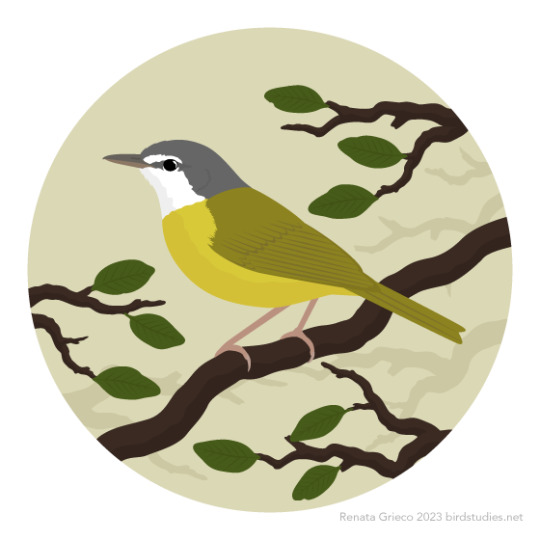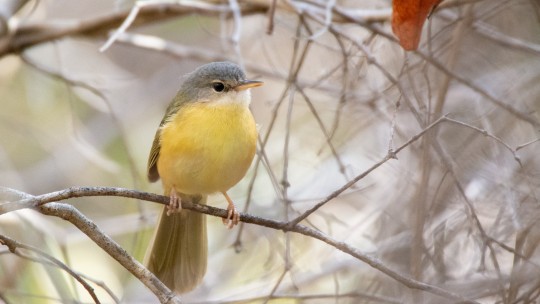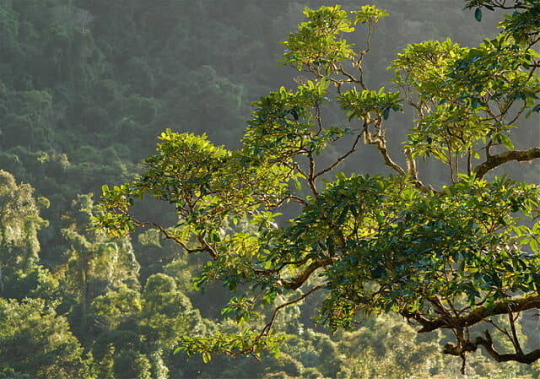#tetraka
Text

January 14, 2023 - Appert's Tetraka (Xanthomixis apperti)
Found only in southwestern Madagascar, these tetrakas live in deciduous and evergreen forest. They feed on arthropods, foraging alone or in small flocks, sometimes with other species, picking insects from leaves, branches, and leaf litter. Little is known about their breeding behavior, but they probably build cup-shaped nests and a subadult was observed in April. They are classified as Vulnerable by the IUCN due to their tiny range and small population which is threatened by habitat loss and degradation.
#appert's tetraka#tetraka#malagasy warbler#xanthomixis apperti#bird#birds#illustration#art#woodland#birblr art
50 notes
·
View notes
Photo

[ A dusky tetraka photographed by John C. Mittermeier. ]
“Dusky Tetraka, a small olive and yellow-throated bird that hops around on the ground and has eluded ornithologists for 24 years, was rediscovered by an expedition team searching the tropical forests of northeastern Madagascar. The expedition team, led by The Peregrine Fund’s Madagascar Program, found the species in two different remote sites: one on the Masoala peninsula in late December 2022 and another near Andapa in January this year. The last documented sighting of Dusky Tetraka was in 1999, making it one of the top 10 most wanted lost birds by the Search for Lost Birds, a collaboration between Re:wild, American Bird Conservancy and BirdLife International.
“Now that we’ve found Dusky Tetraka and better understand the habitat it lives in, we can look for it in other parts of Madagascar, and learn important information about its ecology and biology,” said Lily-Arison Rene de Roland, Madagascar Program director for The Peregrine Fund, and expedition leader. “There is a lot of biodiversity still to discover in Madagascar.””
- Excerpt from “Found: Mysterious songbird rediscovered in Madagascar after eluding scientists for 24 years” via BirdLife International.
58 notes
·
View notes
Text

[302/10,977] Appert's Tetraka - Xanthomixis apperti
Order: Passeriformes
Suborder: Passeri
Superfamily: Sylvioidea
Family: Bernieridae
Genus: Xanthomixis (tetrakas)
Photo credit: Jean-Sébastien Guénette via Macaulay Library
#birds#Appert's Tetraka#Passeriformes#Passeri#Sylvioidea#Bernieridae#Xanthomixis#birds a to z#undescribed#0% - 25%
5 notes
·
View notes
Text
Bird Feared Extinct Spotted First Time After 24 Years
Oh snap??? 👀
0 notes
Text
#Science#science communication#scicomm#Stem#Science education#Science blog#environmental science#endangered species#Birds#Animals
2 notes
·
View notes
Text
By Penny Sarchet
Over the past few months, I’ve had the pleasure of diving deep into the Search For Lost Birds, an initiative that’s steering the world’s army of birdwatchers, conservationists and researchers towards finding 10 of the most enigmatic and important bird species lost to science. There have already been some successes – including the extraordinary rediscoveries of both the Santa Marta sabrewing and the dusky tetraka. Now, an extensive search is underway in New Zealand for the mysterious South Island kōkako, which has become a surprising icon for the nation’s struggle to save its unique bird species from invasive predatory mammals.
There are no photographs of the South Island kōkako, a large blue-grey bird with two fleshy orange flaps known as wattles at the base of its curved black bill. Like many of New Zealand’s endemic bird species, it suffered great losses due to deforestation and the introduction of mammals such as ship rats, stoats and feral cats. The last accepted sighting of the species was in 1967, and it was declared extinct in 2007 – however, a sighting that same year led to its reclassification as “data deficient”. In 2010, the South Island Kōkako Charitable Trust was set up to find it and has been searching ever since.
In 2017, the trust launched a public campaign, asking anyone going deep into backcountry areas to look for the bird and report sightings. “After that, we started getting heaps of reports,” trust manager Inger Perkins told me, but no one has yet won the NZ$10,000 the trust is offering for evidence confirming the elusive bird’s existence.
The campaign, though, has helped make New Zealanders care about this missing bird in a country that’s already filled with unusual and threatened bird species, from the kiwi to the kākāpō. Perkins says that before the trust began drumming up interest, the South Island kōkako got very little attention. There was, however, awareness of the closely related North Island kōkako – very similar except that its face wattles are blue – which has been brought back from the edge of extinction and features on the nation’s $50 bills.
Like many of New Zealand’s recent conservation successes, the preservation of the North Island kōkako has involved thorough efforts to kill mammalian predators. “Wherever it’s surviving, it’s needing regular and intensive trapping to keep the predators down,” says Perkins.
The future of many of New Zealand’s birds depends on the success of Predator Free 2050, an ambitious and difficult project to eliminate rats, European stoats and Australian possums from New Zealand by the middle of this century. Trapping and killing these mammals is one technique that’s being used. Another is dropping poisoned bait by helicopter in unpopulated areas.
“There’s a huge lot of people who just hate the idea of poisoning the forests. But it’s the only major tool, particularly in large, remote areas, for predator control,” says Perkins. She says that projects like the search for the South Island kōkako help to get the public on board with these kinds of measures, helping people to realise that “our forests are not what they used to be, and we do need predator control”.
So, how do you go about finding a South Island kōkako? One intriguing line of inquiry is collecting and analysing audio recordings – a surprising tack to take, given that no definitive recording of the bird’s call exists. However, it’s thought to sound something like its North Island cousin, and to be a haunting call with organ and flute-like notes and some other sounds mixed in.
Using this as a starting point, mathematician Stephen Marsland at Victoria University of Wellington algorithmically generated every conceivable variation of this kind of call, and has used these to comb billions of hours of audio recordings from different locations for possible South Island kōkako calls. In this way, his team was able to identify 250 possible calls, and then narrowed these down further to only five, which are now under review by experts.
But in all the 13 years that the trust has been looking for the South Island kōkako, no definitive evidence has yet come to light. Every year at the trust’s annual meeting, Perkins says they ask themselves, “Is there still value in us putting this effort in?”
What could be the trust’s final searches are now underway, scouring key areas in the north-west of the South Island. “It’s going to be more recorders, more cameras, more hands on the ground – almost like a police search across the hillside where there’s been a murder,” says Perkins.
I’m waiting eagerly for news of how these searches have gone. In a country filled with charismatic bird species, I can’t quite believe that the South Island kōkako has garnered so much attention, with passionate volunteers manning extensive and difficult searches.
But speaking to Perkins helped me understand the wider significance of such projects – even if the South Island kōkako is never found, it has acted as a conservation icon, helping us all to understand what’s at stake in New Zealand.
0 notes
Text
By Penny Sarchet
Over the past few months, I’ve had the pleasure of diving deep into the Search For Lost Birds, an initiative that’s steering the world’s army of birdwatchers, conservationists and researchers towards finding 10 of the most enigmatic and important bird species lost to science. There have already been some successes – including the extraordinary rediscoveries of both the Santa Marta sabrewing and the dusky tetraka. Now, an extensive search is underway in New Zealand for the mysterious South Island kōkako, which has become a surprising icon for the nation’s struggle to save its unique bird species from invasive predatory mammals.
There are no photographs of the South Island kōkako, a large blue-grey bird with two fleshy orange flaps known as wattles at the base of its curved black bill. Like many of New Zealand’s endemic bird species, it suffered great losses due to deforestation and the introduction of mammals such as ship rats, stoats and feral cats. The last accepted sighting of the species was in 1967, and it was declared extinct in 2007 – however, a sighting that same year led to its reclassification as “data deficient”. In 2010, the South Island Kōkako Charitable Trust was set up to find it and has been searching ever since.
In 2017, the trust launched a public campaign, asking anyone going deep into backcountry areas to look for the bird and report sightings. “After that, we started getting heaps of reports,” trust manager Inger Perkins told me, but no one has yet won the NZ$10,000 the trust is offering for evidence confirming the elusive bird’s existence.
The campaign, though, has helped make New Zealanders care about this missing bird in a country that’s already filled with unusual and threatened bird species, from the kiwi to the kākāpō. Perkins says that before the trust began drumming up interest, the South Island kōkako got very little attention. There was, however, awareness of the closely related North Island kōkako – very similar except that its face wattles are blue – which has been brought back from the edge of extinction and features on the nation’s $50 bills.
Like many of New Zealand’s recent conservation successes, the preservation of the North Island kōkako has involved thorough efforts to kill mammalian predators. “Wherever it’s surviving, it’s needing regular and intensive trapping to keep the predators down,” says Perkins.
The future of many of New Zealand’s birds depends on the success of Predator Free 2050, an ambitious and difficult project to eliminate rats, European stoats and Australian possums from New Zealand by the middle of this century. Trapping and killing these mammals is one technique that’s being used. Another is dropping poisoned bait by helicopter in unpopulated areas.
“There’s a huge lot of people who just hate the idea of poisoning the forests. But it’s the only major tool, particularly in large, remote areas, for predator control,” says Perkins. She says that projects like the search for the South Island kōkako help to get the public on board with these kinds of measures, helping people to realise that “our forests are not what they used to be, and we do need predator control”.
So, how do you go about finding a South Island kōkako? One intriguing line of inquiry is collecting and analysing audio recordings – a surprising tack to take, given that no definitive recording of the bird’s call exists. However, it’s thought to sound something like its North Island cousin, and to be a haunting call with organ and flute-like notes and some other sounds mixed in.
Using this as a starting point, mathematician Stephen Marsland at Victoria University of Wellington algorithmically generated every conceivable variation of this kind of call, and has used these to comb billions of hours of audio recordings from different locations for possible South Island kōkako calls. In this way, his team was able to identify 250 possible calls, and then narrowed these down further to only five, which are now under review by experts.
But in all the 13 years that the trust has been looking for the South Island kōkako, no definitive evidence has yet come to light. Every year at the trust’s annual meeting, Perkins says they ask themselves, “Is there still value in us putting this effort in?”
What could be the trust’s final searches are now underway, scouring key areas in the north-west of the South Island. “It’s going to be more recorders, more cameras, more hands on the ground – almost like a police search across the hillside where there’s been a murder,” says Perkins.
I’m waiting eagerly for news of how these searches have gone. In a country filled with charismatic bird species, I can’t quite believe that the South Island kōkako has garnered so much attention, with passionate volunteers manning extensive and difficult searches.
But speaking to Perkins helped me understand the wider significance of such projects – even if the South Island kōkako is never found, it has acted as a conservation icon, helping us all to understand what’s at stake in New Zealand.
0 notes
Text
Rare Songbird Feared Extinct Rediscovered in Madagascar
%Rare Songbird Feared Extinct Rediscovered in Madagascar, The previous documented sighting of the dusky tetraka (Xanthomixis tenebrosa) — one of the top 10 most wanted species by the Search for Lost Birds — was in 1999. The…, 2023-03-06 16:51:00, The previous documented sighting of the dusky tetraka (Xanthomixis tenebrosa) — one of the top 10 most wanted species by the Search for Lost Birds — was…

View On WordPress
0 notes
Link
The dusky tetraka is a songbird with a distinctive yellow throat that is native to Madagascar. Three of them have been sighted in a rainforest in the island's north-east, but in an unexpected habitat. The ground-dwelling birds were in thick vegetation near a rocky river - perhaps a good spot to find grubs and insects.
0 notes
Text
Bird Feared Extinct Spotted First Time After 24 Years
New Post has been published on https://petn.ws/hyFOT
Bird Feared Extinct Spotted First Time After 24 Years

Madagascar Bird Feared Extinct Spotted for the First Time After 24 Years. Credit: Jeff Gibbs / Wikimedia Commons / CC BY-SA 3.0 After 24 years of not being seen, the Dusky Tetraka bird has been rediscovered in northeastern Madagascar. The small bird has an olive and yellow throat and moves around on the ground. A […]
See full article at https://petn.ws/hyFOT
#BirdNews
0 notes
Text

December 5, 2023 - Long-billed Bernieria, Long-billed Greenbul, Common Tetraka, or Long-billed Tetraka (Bernieria madagascariensis)
These malagasy warblers are found in evergreen and deciduous forests in Madagascar. They eat arthropods and small vertebrates, foraging in dense vegetation in flocks, often with other species. Not much is known about their breeding behavior, though one of their nests was a cup built mostly from small twigs in a shrub with a clutch of two eggs.
#long-billed bernieria#malagasy warbler#bernieria madagascariensis#bird#birds#illustration#art#woodland#birblr art
42 notes
·
View notes
Text
Dusky tetraka: Joy as bird feared extinct spotted in Madagascar#Dusky #tetraka #Joy #bird #feared #extinct #spotted #Madagascar
The dusky tetraka is a small bird with a distinctive yellow throat that lives on the ground.
#Dusky #tetraka #Joy #bird #feared #extinct #spotted #Madagascar

View On WordPress
0 notes
Text
Dusky tetraka: Joy as bird feared extinct spotted in Madagascar
The dusky tetraka is a small bird with a distinctive yellow throat that lives on the ground.
#Dusky #tetraka #Joy #bird #feared #extinct #spotted #Madagascar
View On WordPress
0 notes
Text
Dusky tetraka: Joy as bird feared extinct spotted in Madagascar
The dusky tetraka is a small bird with a distinctive yellow throat that lives on the ground.
from BBC News – World https://ift.tt/9nGbAYV
via IFTTT
View On WordPress
0 notes
Text
BBC 0424 2 Mar 2023
9915Khz 0359 2 MAR 2023 - BBC (UNITED KINGDOM) in ENGLISH from TALATA VOLONONDRY. SINPO = 55434. English, dead carrier s/on @0358z then ID@0359z pips and Newsroom preview. @0401z World News anchored by Gareth Barlow. Israeli Finance Minister Bezalel Smotrich's call for the Palestinian village of Hawara to be wiped out by the Israeli government is "irresponsible, repugnant and disgusting," US State Department spokesperson Ned Price said on Wednesday. British Foreign Minister James Cleverly raised the issue of tax searches at the BBC's offices in India during a meeting with his counterpart in New Delhi on Wednesday. Last month, India's tax authorities spent three days searching the BBC offices in New Delhi and Mumbai, where they cloned data from the digital devices of some senior employees. One of Greece's worst-ever rail disasters, which claimed at least 43 lives, was due to "tragic human error", the country's prime minister has said. The local stationmaster has been charged with manslaughter. The Greek transport minister has resigned. Trade unions said collisions have multiple factors and the crash had highlighted chronic deficiencies, including lack of staff, broken signals and outdated facilities. North Korean leader Kim Jong Un urged government officials to engineer a "fundamental transformation" in agricultural production, state media reported on Tuesday, amid fears that the country's food shortage is worsening. Kim said hitting grain production targets this year was a top priority and emphasized the importance of stable agriculture production during the second day of the seventh enlarged plenary meeting of the 8th Central Committee of the Workers' Party of Korea on Monday, according to state news agency KCNA. New York City has agreed to pay $21,500 (£17,900) each to over 300 people who were allegedly boxed in and beaten during racial justice protests in 2020. Scientists have found a previously undiscovered moai on Easter Island, uncovering the large stone statue in a dry lake bed on the tiny, remote island in the middle of the Pacific. Conservationists were celebrating Wednesday the first sightings in 24 years of the dusky tetraka, a yellow-throated songbird native to Madagascar for which ornithologists had feared the worst. An expedition to remote regions of the island nation confirmed two recent sightings of the bird. @0405z "The Newsroom" begins. Backyard fence antenna, Etón e1XM. 250kW, beamAz 315°, bearing 63°. Received at Plymouth, United States, 15359KM from transmitter at Talata Volonondry. Local time: 2159.
0 notes